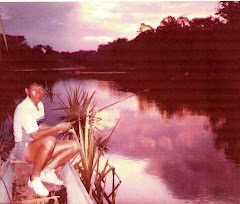The Disappearing Art of "Ngambuh" (making Iban machette/adzes etc)
 My younger brother Linggir trying to kindle a fire during his "ngamboh". The two funnels on the left were used to pump and force the air out to feed the fire where raw steel bars were heated red-hot, before they were hammered into the required shape. Finally, the sharpened edges of the machette (duku), still sizzling hot, were dipped into a tray of cold water to give it that extra strength and sharpness that is the trademark of Iban "duku".
My younger brother Linggir trying to kindle a fire during his "ngamboh". The two funnels on the left were used to pump and force the air out to feed the fire where raw steel bars were heated red-hot, before they were hammered into the required shape. Finally, the sharpened edges of the machette (duku), still sizzling hot, were dipped into a tray of cold water to give it that extra strength and sharpness that is the trademark of Iban "duku".The art of making Iban duku (machette) is slowly being forgotten. Not many, if any at all, make their own nowadays. Why should they, when machettes of all shapes and sizes are easily available in shops just down the road? And they are at an affordable prices too.
But not so very long ago, it was something that Ibans must know. The "dukus" and "beliongs" were some of the most important tools the Ibans must have. Before the saw made their impact in the interior of Sarawak, adzes was of utmost importance. It was the heaviest cutting tool they ever had. Without it, it was impossible to cut down giant trees when clearing the jungle for their hill paddy cultivation.
A "ngambuh" session usually involve at least two people - one to ensure the fire is at its hottest by constantly blowing it manually with the wind funnels and the other, heating, hammering and shaping the steel bar into a machette. Of course one person can do all the job by himself but the work load will be heavier. Depending on the size of the working space, even three people could be overcrowding. However, in order to avoid cluttering the small working space, two is just right.
To make a "duku" may take anything between one to two hours - depending on your efficiency.
The trademark of the Iban "duku" is usually their sharpness, strength and durability. I believed this was because the steel was tempered, compacted and finally the sharpened edges were dipped into a tray of cold water - while the blade was still red-hot.
Today, sad but true, the Ibans, except those that make a living by making it, don't make their own dukus anymore. They buy it from shops. And the affordable prices are a contributory factor that has made the art of ngamboh, a dying practice among the Ibans.





This is a fantastic photo!! I think no one has such a photo. You must actually send a copy to Dato SS.
ReplyDeleteGreat post too. Love it.
I saw a Penan parang maker in Long San about 10 years ago. May be the family still lives there by the river side just below the St.Pius church.
Chang Yi,
ReplyDeleteThanks. That photo must be over 20 years old. I was accompanying my younger brother making a duku.
is it duku ilang sir?
ReplyDeletecapt izuddin 2 RRD..capt_izuddin@yahoo.com
Capt Izuddin,
ReplyDeleteNo, It is not the parang ilang which is used to fight. Duku (machette) is a parang which the Ibans wear where ever he goes - to his garden, to the jungle and when he taps rubber. He is not properly dressed if he does not wear one.
This duku is extra sharp and strong, unlike the ones you buy in shops which are massed-produced. The Iban duku are tempered. That is why they are so sharp and strong.
Where was the earliest iron coming from last time before the coming of commercial iron?
ReplyDelete